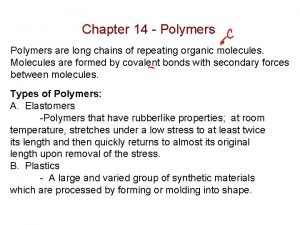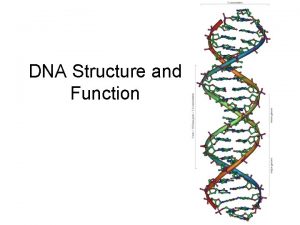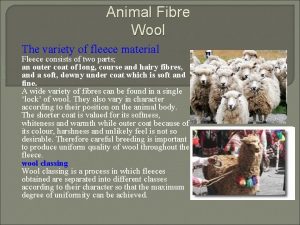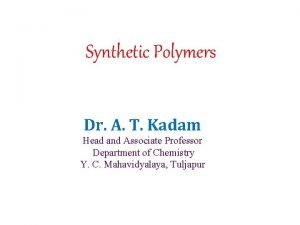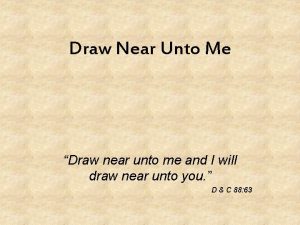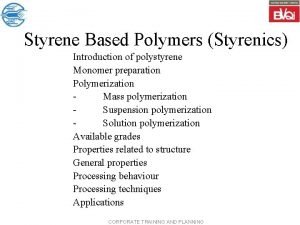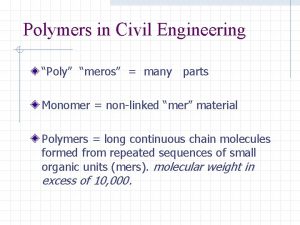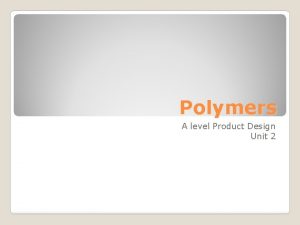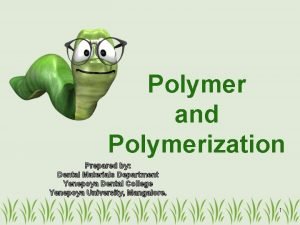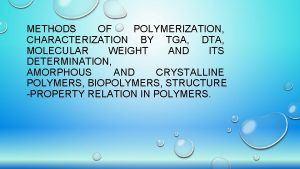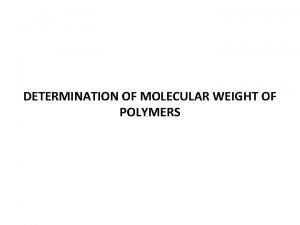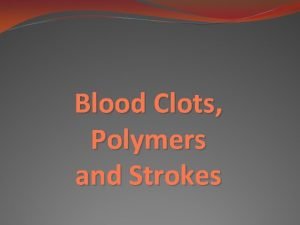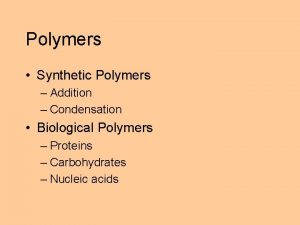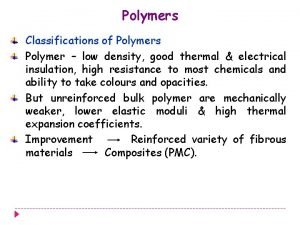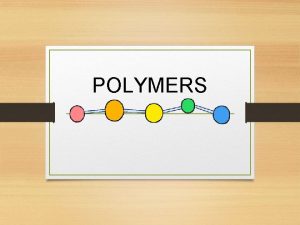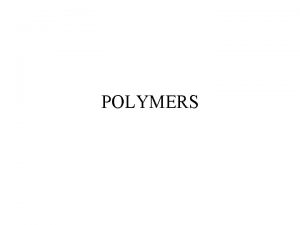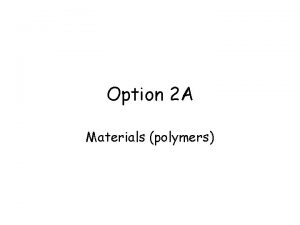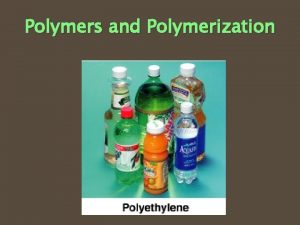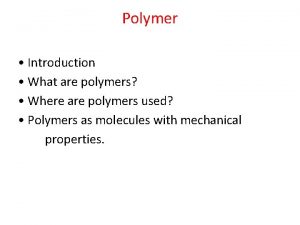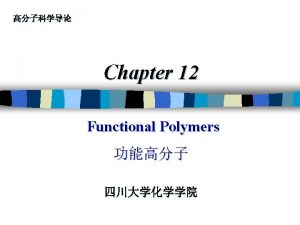Polymers Draw the structure of a polymer Match















- Slides: 15

Polymers * Draw the structure of a polymer ** Match the types of plastic to their use – thermoset/thermoplastics *** Explain how polymerisation works using a diagram and showing the bonds

What are polymers? * Draw the structure of a polymer ** Match the types of plastic to their use – thermoset/thermoplastics *** Explain how polymerisation works using a diagram and showing the bonds

What do we make polymers from? * Draw the structure of a polymer ** Match the types of plastic to their use – thermoset/thermoplastics *** Explain how polymerisation works using a diagram and showing the bonds

What are the different types of polymer? * Draw the structure of a polymer ** Match the types of plastic to their use – thermoset/thermoplastics *** Explain how polymerisation works using a diagram and showing the bonds

• http: //bpes. bp. com/secondaryresources/science/ages-14 -to-16/chemical-andmaterial-behaviour/polymerisation/ * Draw the structure of a polymer ** Match the types of plastic to their use – thermoset/thermoplastics *** Explain how polymerisation works using a diagram and showing the bonds

Polymers (Greek) poly = “many” meros = “part” Each polymer molecule is made from a repeating unit: a monomer Monomers are small molecules (not single atoms). polymerisation monomers * Draw the structure of a polymer Single polymer chain ** Match the types of plastic to their use – thermoset/thermoplastics *** Explain how polymerisation works using a diagram and showing the bonds

Size and shape matter Polymer chains are like long bits of string. The polymer’s properties depend on many factors: • length of chains • type of monomer(s) • side-links and branches • temperature • time taken for polymer to cool down • other chemicals present * Draw the structure of a polymer ** Match the types of plastic to their use – thermoset/thermoplastics *** Explain how polymerisation works using a diagram and showing the bonds

Arrangement of the chains The length of the chain can be controlled. The chains are thousands or millions of units long. DNA: a very complex polymer up to 220 million units long. * Draw the structure of a polymer ** Match the types of plastic to their use – thermoset/thermoplastics *** Explain how polymerisation works using a diagram and showing the bonds

Chain length They twist and bend and tangle with each other, but can also line up neatly. Chains entangled (amorphous) * Draw the structure of a polymer Chains aligned (crystalline) ** Match the types of plastic to their use – thermoset/thermoplastics *** Explain how polymerisation works using a diagram and showing the bonds

Branching and cross-linking Sometimes they can have branches, or they can be linked to other chains. Different types of branching * Draw the structure of a polymer Cross-linked chains ** Match the types of plastic to their use – thermoset/thermoplastics *** Explain how polymerisation works using a diagram and showing the bonds

• Which of the following molecules could be used as monomers? Explain your answer. A B * Draw the structure of a polymer ** Match the types of plastic to their use – thermoset/thermoplastics C *** Explain how polymerisation works using a diagram and showing the bonds

• • The solid lines represent covalent bonds. A thermosoftening plastic: A thermosetting plastic: Note: • Polyethene is a thermoplastic. • Bakelite is a thermosetting plastic. Use the diagrams to explain the following observations. • Polyethene is flexible • Bakelite is rigid • Polyethene melts when heated. • Bakelite does not melt when heated Use Thermoplastic or thermosetting plastic? Ash tray Carrier bag Electric plug Packaging * Draw the structure of a polymer ** Match the types of plastic to their use – thermoset/thermoplastics *** Explain how polymerisation works using a diagram and showing the bonds

Making slime • PVA is a polymer • We add borax which forms the borate ion in solution * Draw the structure of a polymer ** Match the types of plastic to their use – thermoset/thermoplastics *** Explain how polymerisation works using a diagram and showing the bonds

The chemistry of slime • What has happened to the PVA? • How has the structure changed? * Draw the structure of a polymer ** Match the types of plastic to their use – thermoset/thermoplastics *** Explain how polymerisation works using a diagram and showing the bonds

Polymers • Putting all the information you know together, make a double spread page about polymers. • Use connectives to improve the quality of writing and make your point. * Draw the structure of a polymer ** Match the types of plastic to their use – thermoset/thermoplastics *** Explain how polymerisation works using a diagram and showing the bonds
 Structure of polymers
Structure of polymers Nucleic acid structure
Nucleic acid structure Addition polymers 2 chemsheets answers
Addition polymers 2 chemsheets answers Structure of wool polymer
Structure of wool polymer Saran wrap polymer structure
Saran wrap polymer structure Draw near unto me and i will draw unto you
Draw near unto me and i will draw unto you How to draw use case diagram in draw.io
How to draw use case diagram in draw.io X mold
X mold Thermal polyaspartate
Thermal polyaspartate Polystyrene monomer
Polystyrene monomer Why do different polymers have different properties?
Why do different polymers have different properties? Advantages and disadvantages of thermoplastics
Advantages and disadvantages of thermoplastics 2 types of plastic
2 types of plastic Polymeric dental materials
Polymeric dental materials Homochain polymers
Homochain polymers Methods to determine molecular weight of polymer
Methods to determine molecular weight of polymer
